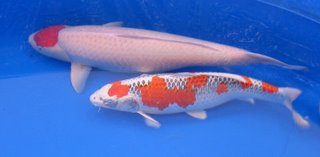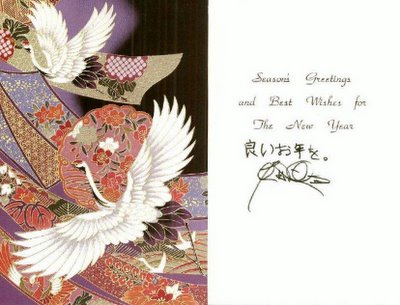Sunday, March 26, 2006
CATASTROPHE
Saturday, March 25, 2006
King Eagles Pachinko & Slot Parlor
 I was out the other day without my camera and took this picture with my cell phone. It is a Pachinko Parlor and the young men lined up outside are waiting to get in early in the morning. When the door opens, they rush inside to get the "best" machine. According to reliable sources, there are professional pachinko players.
I was out the other day without my camera and took this picture with my cell phone. It is a Pachinko Parlor and the young men lined up outside are waiting to get in early in the morning. When the door opens, they rush inside to get the "best" machine. According to reliable sources, there are professional pachinko players.Now, I have never played pachinko. But I have seen it and for the life of me cannot figure how you can make a living playing pachinko. It doesn't even require skill - it is pure luck. But I am assured that somehow you can put the odds in your favor. I think it is something about if the machine sits there long enough without paying, it will eventuall pay off big.
When you win, you get little prizes (because it is illegal to get money). Then you take the prizes around back and trade them for money. Hmmm... The only people making money off pachinko are the owners of the parlor I think. I didn't see any of the young men dressed that nicely or driving expensive cars in the line outside. We can also throw our money at the lottery. Haven't I written about Pachinko before? I know I have written about cherry blossoms. I feel like Yogi Berra: "It's deja vu all over again".
Girls in Uniform
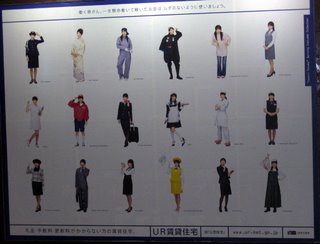 I saw this sign at the train station in Kawasaki. It is labeled to the side:
I saw this sign at the train station in Kawasaki. It is labeled to the side: Kawori Manabe Working Costumes Collection
And the individual uniforms or "costumes" are: Policewoman, Bar Hostess, Car Mechanic, Carpenter, Kindergarten Teacher, Office Worker, Nurse, Gas Station Attendant, Flight Attendant, Maid, Sushi Chef, Hamburger Shop Girl, Elevator Attendant, White Collar Worker, Bartender, Sightseeing Bus Guide, Secretary, and Fishmonger.
And that is all I know about that.
V=6860
Sakura Starting to Bloom
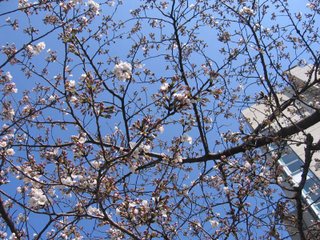 The cherry trees are starting to bloom. This tree is just down the street from my apartment at the bridge that crosses the intersection to the school. It is the first cherry I remember seeing bloom when I first got to Japan. I can't miss it. When I cross the bridge it is just overhead.
The cherry trees are starting to bloom. This tree is just down the street from my apartment at the bridge that crosses the intersection to the school. It is the first cherry I remember seeing bloom when I first got to Japan. I can't miss it. When I cross the bridge it is just overhead.Anyway, they look like they are going to bloom in the Tokyo area a little early. This one will probably be in full bloom by mid-week. We planned our office Hanami (Flower Viewing Party) for April 7th and chances are they will pretty much be gone by then. Accordingly, we have adjusted the plan to just having a walk in the park sans sakura no hana and then having a party.
Meanwhile, with my usual penchant for poor timing, I am going to Doha the week of the party and will fly back in on the 6th. So I will probably miss the main bloom this year but at least I'll be at the party.
In Japan, the cherry blossom represents the fragility and shortness of life as well as the beauty. Sometimes you miss out on a few things in life, so, missing the cherry blossom peak is just one of those things. You just have to capitalize on things when you get the chance...
Wednesday, March 22, 2006
The First Day of Spring
Sure enough, the fashionable young men had changed to pastel shirts with matching ties. And women were wearing light colored coats and the boots, alas, are starting to disappear.
Yesterday it was warm but by this morning it had turned cold and rainy. But I saw the first cherry buds breaking open in the Tokyo area this morning on my way to train. One tree was even pretty much blooming. The seasons are changing…
Tuesday, March 21, 2006
Daibutsu at Kamakura
 A plum blooms in front of the Daibutsu (Great Buddha) at Kamakura. It was cast in 1252 by the sculptors Ono-Goroemon and Tanj-Hisatomo at the request of Miss Idanonotsubone and Priest Joko according to the tribute at the site. In 1498 a tsunami swept away the temple that covered it leaving it in the open air. The buddha weighs about 121 tons and is 13.35 m tall.
A plum blooms in front of the Daibutsu (Great Buddha) at Kamakura. It was cast in 1252 by the sculptors Ono-Goroemon and Tanj-Hisatomo at the request of Miss Idanonotsubone and Priest Joko according to the tribute at the site. In 1498 a tsunami swept away the temple that covered it leaving it in the open air. The buddha weighs about 121 tons and is 13.35 m tall.
Sunday, March 12, 2006
Girls in the Park
Ume no Hana
Saturday, March 11, 2006
The Great Buddha in Nara
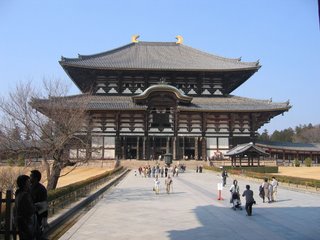 The Todai-ji in Nara houses the Great Buddha. Cast in 752 by a Korean artist, it is made of bronze and weighs 100s of ton. It is the largest bronze image of the Buddha (see picture behind Yebisu) in the world. The building has been rebuilt several times. The current structure dates from 1709 and is only 2/3rds the size of the original. It is still the largest wooden building in the world.
The Todai-ji in Nara houses the Great Buddha. Cast in 752 by a Korean artist, it is made of bronze and weighs 100s of ton. It is the largest bronze image of the Buddha (see picture behind Yebisu) in the world. The building has been rebuilt several times. The current structure dates from 1709 and is only 2/3rds the size of the original. It is still the largest wooden building in the world.
The Golden Pavillion
 The famous Golden Pavillion (Kinkagoji) in Kyoto is a Buddhist temple that was originally the home of a Shogun. Built around 1400, the original was unfortunately destroyed by arson in 1950. This exact replica is covered in gold leaf and topped by a bronze phoenix just like the original.
The famous Golden Pavillion (Kinkagoji) in Kyoto is a Buddhist temple that was originally the home of a Shogun. Built around 1400, the original was unfortunately destroyed by arson in 1950. This exact replica is covered in gold leaf and topped by a bronze phoenix just like the original.Look behind Ebisu for some more pictures of Ebisu and Nara...
Friday, March 03, 2006
Firenze
 I have just returned from a trip to Firenze, Pisa, Paris, and Doha. I think I have published pictures of the last three before so I thought I'd show you something from Firenze (Florence).
I have just returned from a trip to Firenze, Pisa, Paris, and Doha. I think I have published pictures of the last three before so I thought I'd show you something from Firenze (Florence).Firenze is a nice small city and of course famous for it's contribution to the Renaissance. It is also famous for wine, food, and fashion - especially leather (think purses Megan). Here are 5 different views of the famous cathedral in Firenze, the Duomo, starting in the upper left and going clockwise.
1 The dome visible over buildings from my hotel window
2 Inside the cathedral looking up at the dome
3 The facade of the cathedral
4 The baptistry with cathedral and dome in back
5 The main entrance
On this trip Ikeda-san bought a $100 bottle of Tuscany wine in a restaurant that I was unable to fully appreciate but thought was very good indeed. Ikeda-san likes wine whereas Hatta-san likes sake. I have decided wine is more likely to give me a headache and I'm leaning towards Hatta-san.
This week my visitors show up and we are going to Kyoto and Nara. There should be more Japanese pictures in the next posting...
V=6703
Saturday, February 18, 2006
Shinkansen
 The Japanese name for the bullet train is shinkansen which means literally "new main rail line" but you may see it translated as super express or more popularly as bullet train. The shinkansen system has been in place now for a number of years and there is an extensive network throughout Japan. In the picture you can see a number of different models that have come out over the years.
The Japanese name for the bullet train is shinkansen which means literally "new main rail line" but you may see it translated as super express or more popularly as bullet train. The shinkansen system has been in place now for a number of years and there is an extensive network throughout Japan. In the picture you can see a number of different models that have come out over the years.The largest is the "Max" which is the extra wide double decker in the upper left. The oldest model is the bullet shaped one on the far lower left.
The rail infrastructure here is amazing. The local train and underground in the Tokyo area is clean, safe, very much on time, and at rush hour very crowded. The shinkansen is convenient, comfortable, and fast.
In Japan, there are a lot of train nuts. They want to see, ride, model, photograph, etc. It is the usual bunch of fanatics - young boys and middle aged men. You can buy a special low cost ticket that lets you stand on the platform like I did here and take pictures. Neat...
Monday, February 13, 2006
Haiku for Early Spring
一輪ほどの
あたたかさ
うめいちりん
いちりんほどの
あたたかち
ume ichi rin
ichi rin hodono
atatakachi
A singe plum blossom
I feel the warmth
About the amount of a blossom
I will quote Naoko-san who explains this poem in a way that is as nice as the poem itself:
Plum flowers blossom earlier than Cherry. Some people like plum flowers better than cherry because of the scent.
When I was a student, we could not wait for cherry blossoms and had a party under plum trees. It was too cold of course, and we had to move to an izakaya shortly.
The plums are not blooming yet but we are starting to get some warm days. You can see the buds swelling. Soon...
Sunday, February 12, 2006
About Japanese Green Tea
 Here is my tea pot and cups. I got it on sale just like the sake set and at the same place. The pot is hand made and was pretty expensive. The cups are everyday ware but match it well and are pretty I think. Anyway, I like it. Simple and contemporary but definitely Japanese.
Here is my tea pot and cups. I got it on sale just like the sake set and at the same place. The pot is hand made and was pretty expensive. The cups are everyday ware but match it well and are pretty I think. Anyway, I like it. Simple and contemporary but definitely Japanese.So how do you make Japanese tea anyway? And what about the tea ceremony? Forget the tea ceremony. I only know one person my age or younger that knows anything about it. It is esoteric, it is impossible for you and me to sit the proper way that long, and it takes years to learn. If you want to know about it, there are places that do it for tourists (mostly Westerners) .
The word for tea is "cha" which is of Chinese origin. Black Chinese tea is called "kocha" and Japanese green tea is called "ocha". The Japanese like all kinds of tea, including iced tea, lemon tea, jasmine tea, herbal tea, any kind of tea. But the favorite is probably ocha.
Like sake, there are lots of kinds of ocha. I suggest you ask for "sencha" which is the most common type. Sencha can vary widely in quality and cost. Since I don't drink that much, I tend to get the better ones. For me, green tea was something of an acquired taste but I enjoy it now. And of course it has cancer fighting anti-oxidants and is supposed to be good for you. Here is how to make the tea:
Recipe
Bring water to a boil in a special iron kettle over a charcoal fire and cool it to 70 degrees C. by mixing it with an already cooled bowl of water in a special pouring bowl, and using years of experience and the hands to feel, assure the proper temperature. The bowls and cups not being used should be kept on a special lacquered tray, preferably passed down from your ancestors. Or use a computer controlled electric kettle set at the desired temperature like I do and put the pot and cups on the counter.
Pour some water into the tea pot to warm it. Pour that water into the cups to warm them. Now, put the loose tea into the pot. Use about 3 gms of tea per cup. This is more than a teaspoon but less than a tablespoon I think. I use my tea cup to measure the hot water into the pot but the directions the store lady gave me was 60 ml per cup. Steep the tea for 2 minutes.
Notes: A traditional Japanese tea pot has holes or striations in the pot to form a strainer. Some of the newer ones use a stainless steel or fabric screen that fits into the pot. Anyway, you need something to strain it. You can also buy a special container to keep the unused tea in but I haven't done that.
Serving
If you are a good host, you will make each cup the same strength. Pour a little into the first cup, and then quickly move to the next cup, and so on for each cup. Then go back to the first cup and do it again, making several round until you finish with each cup having the same level. You must pour the final drop from the pot! Shake a few drops into each cup, moving from cup to cup, just like you poured it.
The tea will be warm, rather than real hot, and a very light green. For the very best tea, you should actually brew it a little cooler and longer. This reduces the bitterness and astringency. I hope I don't need to tell you not to put sugar in it.
Enjoy...
V=6600
How to drink Sake
There are all kinds of nihonshu (Japanese word for sake, remember?). Pay attention now :-). First, nihonshu must be high quality and it needs to be dry. Don't drink from those big plastic bottles they sell for 1,200 yen. Ask for "ginjyo". For dry, ask for "karakuchi no" but this isn't really necessary because ginjyo is aways dry. Now this is important - don't drink good nihonshu hot. Ask for "reishu" which means chilled. If you are a new comer to sake, drink some beer first to condition your palate. The sake won't seem strange after some beer. I skip this step.
To my children: Do not drink and drive. Do not drink too much. You don't see your father doing that do you?
Sunday, February 05, 2006
Stuff
 Stuff: I really don't have much stuff here but I bought some more today. I have been looking around for a sake serving set and finally bought this one. I have been looking for a tea set for two years and still haven't bought that but I think I'm getting close now. I like this sake set. It is kind of monchromatic and has nasu (eggplant) on it. A very modern design. It is sitting on my empty kitchen counter.
Stuff: I really don't have much stuff here but I bought some more today. I have been looking around for a sake serving set and finally bought this one. I have been looking for a tea set for two years and still haven't bought that but I think I'm getting close now. I like this sake set. It is kind of monchromatic and has nasu (eggplant) on it. A very modern design. It is sitting on my empty kitchen counter.Anyway, like I said, I don't have that much stuff. You really don't need it do you? I haven't lived with this little stuff since college.
My apartment is furnished so I don't really need a lot. Kathye said it looked like I was "camping out" but I'm camping out in pretty good luxury. Here is a list of what I actually own by room. I am excluding consumable stuff like food and things that aren't meant to last like toothbrushes as well as the furniture and appliances that were provided.
The entry way has 2 pairs of running shoes, 2 pairs of dress shoes, my backpack with camera and electronic dictionary, my coats and umbrella. I also have my lucky maneki neko temple cat there. In the bathroom there is an electric shaver and a little clock.
In the bedroom I have some pictures. In the closet are my clothes hanging on about 5' of hanger space and 6 drawers with all my clothes. I have 2 suitcases.
In the hall is my incense burner that I never use on a tiny little table. In the spare bedroom I have a computer and printer. In the living room I have a TV, stereo, MASSAGE CHAIR, my books on Japan, a few pictures, a nice Chinese tea pot I bought in Kuala Lumpur years ago, and a vase made by my Grandmother.
In the kitchen I have a coffee grinder, expresso machine, some coffee cups, and my new sake set. Oh yeah, almost forgot, some Yebisu beer glasses and two bowls from the Sumo match.
Come to think of it, that is a lot of stuff. Maybe I should get rid of some of it.
V = 6537
Sunday, January 29, 2006
The Kabuki Theater in Tokyo
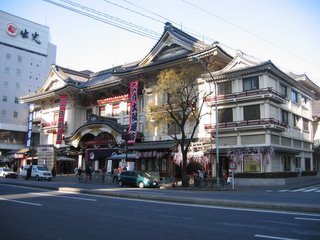 All the guide books have Kabuki in them. It is esoteric theater that hasn't changed in hundreds of years and is spoken in obscure dialect by an all male cast.
All the guide books have Kabuki in them. It is esoteric theater that hasn't changed in hundreds of years and is spoken in obscure dialect by an all male cast.When I first got here it was definitely on my list of things to do. The fact is, I only know one Japanese person who has ever been: Hatta-san's wife. Actually Hatta-san volunteered her to take me, and I am sure she would, but after two years I'm almost feel Japanese enough that it seems silly for me to go. I mean, I don't want to act like a tourist or anything.
I went in my favorite "kaitenzushi" restaurant in Shinbashi today and it was pretty crowded at the counter. There was another "gaijin" (foreigner) there and the waitress, who knows I am a regular, led me away to a better seat at the back so I wouldn't have to sit by him. This pleased me to no end and I made sure to speak Japanese to the waitress as we went by him so there would be no doubt why I was getting special treatment.
Pretty silly, huh? Actually, I don't get mistaken for being Japanese very often :-). Take care and enjoy doing whatever silly thing you are doing...
Shibuya at Night
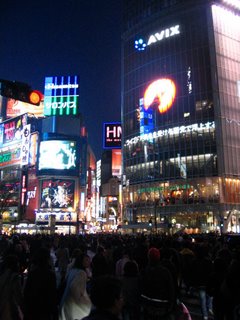 OK - here is Shibuya at night again for those who like these pictures. This is the crossing on the west side of Shibuya station. Click on the picture to enlarge it, look carefully at the street, and you can see it is completely crowded with people crossing. This is really one of the coolest things about Tokyo - millions of people day and night in a bright, crazy, but safe setting.
OK - here is Shibuya at night again for those who like these pictures. This is the crossing on the west side of Shibuya station. Click on the picture to enlarge it, look carefully at the street, and you can see it is completely crowded with people crossing. This is really one of the coolest things about Tokyo - millions of people day and night in a bright, crazy, but safe setting.See the Starbucks Coffee on the second level? You can't get away from them. There are two on the block where I live. Come see me though and I'll have a cup of coffee with you maybe here. It looks like a good place to watch the crowd.
I was out looking for a Japanese teapot today but still haven't found just the right one after two years. I got pretty close to buying one today but then I couldn't find cups I liked with it. I think I will be able to find the one I want if I just keep looking a few more months.
V = 6484
Saturday, January 21, 2006
The 37th All Combined Nishiki Goi Show -1-
 Remember last year's koi show? Here are a few pictures from this year. They really are amazing fish. There were some very unusual ones this year but I didn't get too many really good pictures. The lighting isn't good for pictures - there is a lot of glare.
Remember last year's koi show? Here are a few pictures from this year. They really are amazing fish. There were some very unusual ones this year but I didn't get too many really good pictures. The lighting isn't good for pictures - there is a lot of glare.Feel free to cast a vote for your favorite fish again if you like.
At the top in this photograph are three Taisho Sanke with a Kohaku at the bottom.
The second photograph shows a very nice Tancho Kohaku with a Koromo. Of the fish on this page the Koromo is probably my favorite.
At the bottom is another Taisho Sanke. This one was huge - over 80 cm long and very impressive.
Snow in Tokyo
 It is pretty here when it snows. It is an infrequent event - maybe a snow like this once a year. Today's snow was wet and since it was just above freezing not sticking that well.
It is pretty here when it snows. It is an infrequent event - maybe a snow like this once a year. Today's snow was wet and since it was just above freezing not sticking that well.This view is of the famous Zojoji Temple down from my apartment. You can see the base of Tokyo Tower in the background at right.
V=6386
Friday, January 20, 2006
Megan's Purse
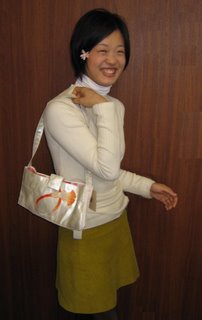 This week's picture is Kanako-san showing the purse she made for Megan's Christmas present. Megan is a purse collector and this one is the only one like it in the world. It is made from an embroidered obi (sash to a kimono). I found the obi in a shop that specializes in kimono, and has a number of old ones which is where this one came from.
This week's picture is Kanako-san showing the purse she made for Megan's Christmas present. Megan is a purse collector and this one is the only one like it in the world. It is made from an embroidered obi (sash to a kimono). I found the obi in a shop that specializes in kimono, and has a number of old ones which is where this one came from.Kanako-san is a secretary in the office who was trained as a weaver of cloth but is working as a secretary until she makes it in fashion. Anyway, she is a good seamstress too and I saw some purses she had made and asked if she could make one from the obi. She agreed and just finished this one.
I must give myself some credit, but it is pretty clear who has the talent. Also, she is cute and keeps asking about David from the picture in my office. Megan, I hope you enjoy it... Dad
Sunday, January 15, 2006
My Boring Life in Japan
But, I've been doing very well on my New Year's Resolutions. Number 1 was to start exercising regularly again and I give my self an A+. Number 2 was to quit being so uptight about everything at work - in other words not to worry about things I can't change. I give myself a B on that so far.
I can't blame anyone but myself for doing nothing this last weekend. Next week is the annual Tokyo Koi Show so I plan to go to that. Hope you are getting out regardless of what the weather is like...
Sunday, January 08, 2006
shin nen akemashite omedetou gozaimasu
Actually, today is seijin no hi - Coming of Age Day. As I've explained before, this is a day to celebrate young people turning 20. Since David is now 20, we should offer congratulations to him so "omedetou gozaimasu".
Have a great New Year...
V = 6303
Thursday, December 29, 2005
Where is Waldo Today?

Here we are at the Houston Museum of Natural Science. Did you know that there are beavers in East Texas? The Texas beavers don't build dens like some other North American beavers - their dens are dug into the side of the creek. But they do have flat tails (I'm not referring to nutria here).
Anyway, they had a special exhibition on Egypt at the museum and they gave us 3D glasses to view it. See the photo behind Yebisu for an idea of how silly this was.
Hope you are enjoying the holidays and yoi otoshi wo (happy New Year). My New Year's card posted below has the same greeting in kanji on the card. The title of that posting is the greeting written in hiragana.
New Years is probably the most important holiday in Japan. At the end of the year, everyone cleans their house good inside and out. Special food is prepared that has a good "shelf life" so that everyone can enjoy the feast but not spend time cooking. New Year's eve is a time to get together with family and friends and maybe watch the holiday specials on TV.
The local temple will ring the bell 108 times to get rid of old sins before midnight. After midnight they will ring it 108 more times to ward them off in the New Year. Lots of people go the temple for food, a little ame-sake, prayer, and a good luck charm.
May you have a healthy, prosperous, and happy year in 2006...
Friday, December 16, 2005
Monday, December 12, 2005
I'm not the Only One having Trouble
The problem apparently with kanji is that most children can READ it but they have trouble WRITING it on grade level. Apparently their parents aren't much better. The secretaries will look it up on their phones or the word processor before writing sometimes.
There are TV shows now being aired which capitalize on the poor state of affairs. On an episode of "Quiz! Nihongo-O!" only 17 of 30 contestants could produce the kanji for nose which is learned in the third grade. The Japanese word for nose is hana (also means flower but has a different kanji). Here is the kanji for snout:
鼻
Hmmm....
Saturday, December 10, 2005
More on Kanji
Symbols Required: Phonetic alphabets are the clear winner here if you think less is more. Kanji has around 2000 characters in common use and Chinese even more.
Language Specificity: You might think that phonetic alphabets are the winner here too but not so quick please. While it is possible to write Japanese in the Roman alphabet, you would have no idea what you are reading unless you know Japanese. If you know Kanji, you would also be able to read Chinese to a fair degree also without knowing any Chinese at all.
Ease in Learning: I think this is a no-brainer. Phonetic alphabets are quicker to learn because of the fewer number of symbols.
Speed in Reading: The jury is out on this for me. Intuitively to a Western mind the phonetic alphabet would be quicker to process. This seems wildly counter intuitive to anyone brought up on Kanji. They believe the symbol is processed immediately and can be linked together in a speed reading style. Also, consider this: The Arabic numbers (1, 2, 3, 4, etc.) are basically symbols representing the idea of numbers (e.g. one, two, three, four, etc.). Which of the following is easier to process:
- 14,597.6
- Fourteen thousand, five hundred and ninety seven point six
I dunno, but I am getting too old to learn a couple of thousand new characters to represent my feeble thoughts...
V = 6015
Tuesday, December 06, 2005
You can eat the whole thing...

According to Ikeda san, there are 3 fish where you can eat the internals: the ankou (lantern fish), tara (cod), and the fugu (blow fish). Of course you can't eat the ovaries or the liver of fugu because they are highly poisonous. That ankou is an ugly critter isn't he? Anyway, I have partaken of the internals of all three. The liver of the ankou is the most unusual tasting although certain parts of the cod aren't far behind. Fugu is very mild. Anyway, I just thought you might like to know...


